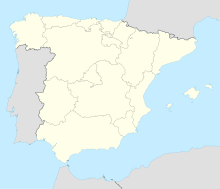Roman amphitheatre of Italica facts for kids
|
Anfiteatro romano de Itálica
|
|

View of the amphitheatre
|
|
| Location | Santiponce (Seville), Spain |
|---|---|
| Coordinates | 37°26′38″N 6°02′48″W / 37.44389°N 6.04667°W |
| Type | Roman amphitheatre |
| History | |
| Founded | AD 117 and 138 |
| Periods | Roman Empire |
The Roman amphitheatre of Italica is an amazing ancient building. It is located in what was once the Roman city of Italica. Today, this area is called Santiponce in Seville, Spain. This grand amphitheatre was built a long time ago, between the years 117 and 138 AD. This was during the time of Emperor Hadrian, who was actually born in Italica!
This amphitheatre was one of the biggest in the entire Roman Empire. It could hold about 25,000 people. Imagine that many people watching a show! People came to see exciting gladiator fights. They also watched battles between wild animals, or even between people and animals.
The city of Italica was mostly left empty by the Romans in the 3rd century. But the amphitheatre was found again during the Renaissance period in the 1600s. Work to dig up and uncover the amphitheatre started in the late 1800s. Today, the amphitheatre is in ruins, but it is a popular place for tourists to visit and learn about history.
Contents
What the Amphitheatre Looked Like
The amphitheatre had an oval shape. It was about 160 meters (525 feet) long and 137 meters (449 feet) wide. It had three levels of seats for the audience. The first level is still mostly complete. The second level is partly there, but the third level is mostly in ruins.
Under the Arena Floor
Underneath the main stage, called the arena, there was a special service area. This area was used for all the different shows. It was especially important for the gladiator fights and the battles with wild animals. The building was made from strong rocks like siliceous and calcareous pebbles. This was because there wasn't much natural stone in the area.
Seating Areas
The seating area, called the cavea, was split into three main parts. These parts were separated by circular walkways.
- The ima cavea was the lowest section. It had 6 rows of seats and 8 entrances. This area was for the most important people, like rulers.
- The media cavea was the middle section. It had 12 rows of seats and 14 entrances. This area was for regular people.
- The summa cavea was the highest section. It was covered by a large awning to provide shade. This area was usually for children and women.
Special Rooms
The amphitheatre also had several rooms. These rooms were used for worshipping ancient Roman gods. Some were dedicated to Nemesis, the goddess of revenge, and Juno, the queen of the gods.
See also
 In Spanish: Anfiteatro de Itálica para niños
In Spanish: Anfiteatro de Itálica para niños
Images for kids


